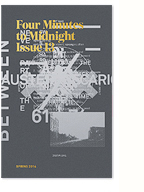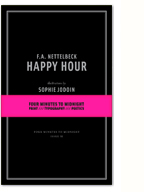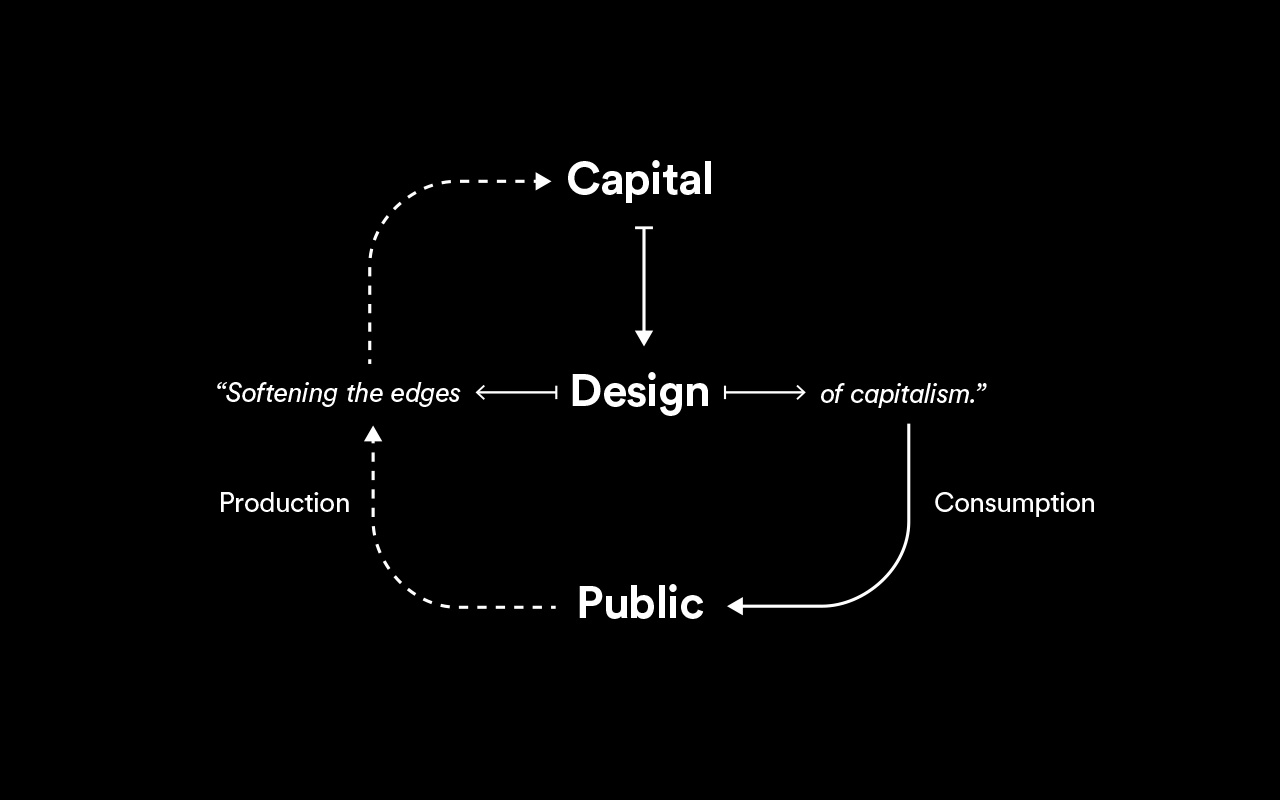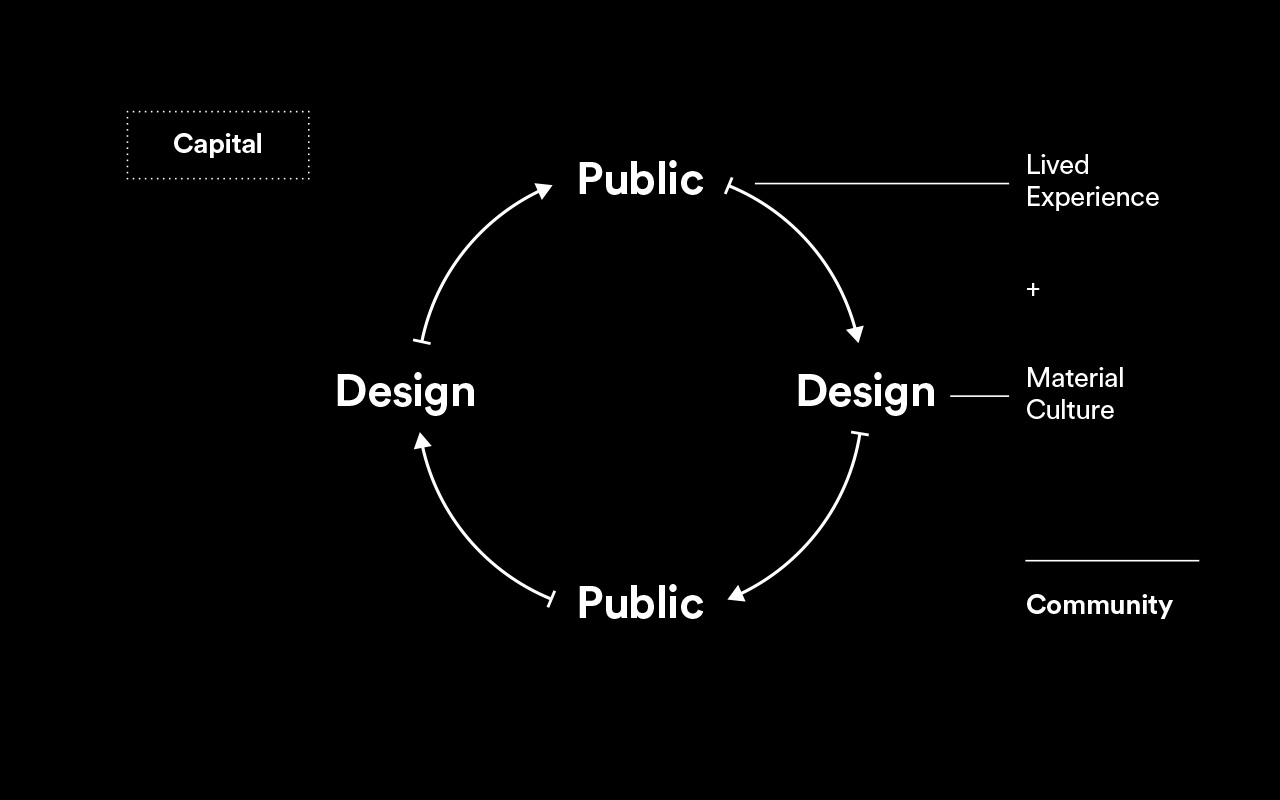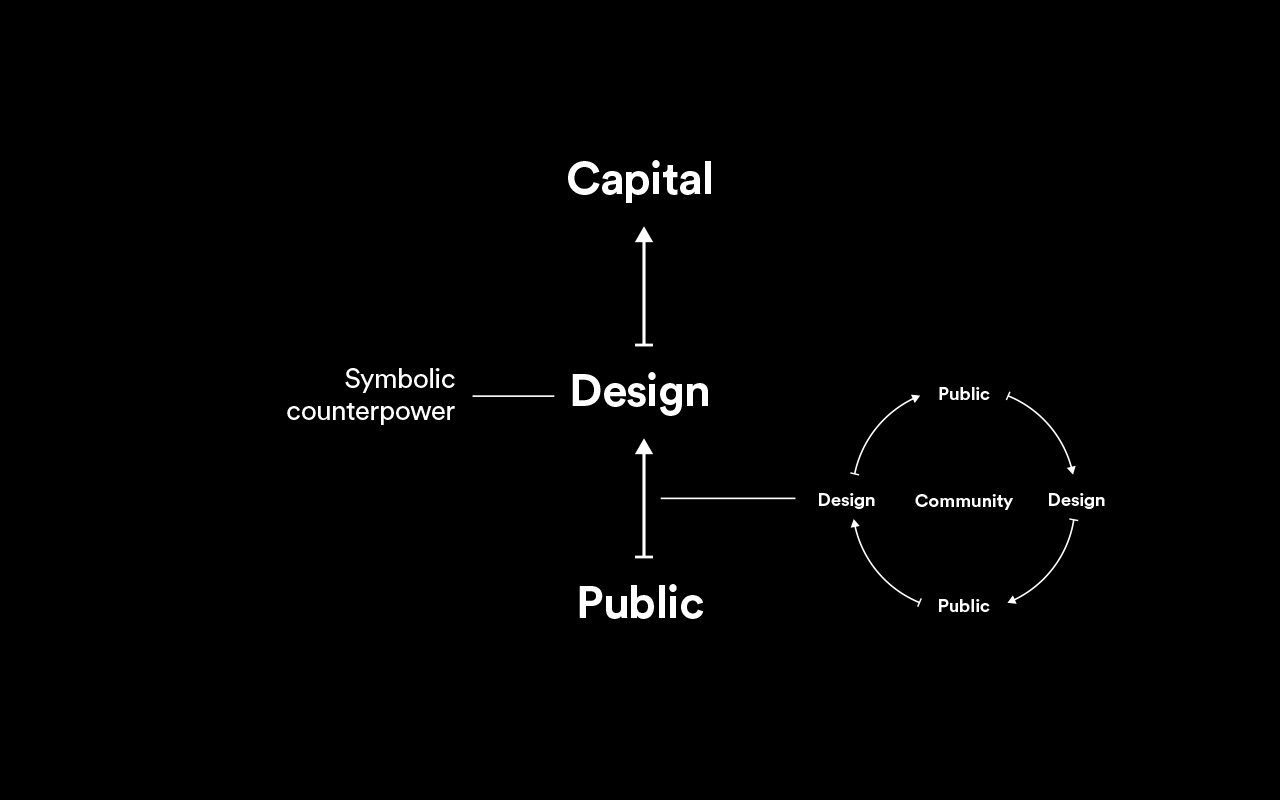Last week I was invited to present my work and launch the latest issue of Four Minutes to Midnight at Jackpine in Ottawa, as part of their Shoufen series of talks. In order to contextualise my practice, I presented the following diagrams illustrating design’s relationships with capitalism that I had originally drafted to accompany Vincent Tao’s excellent research presentation Design-Labour-Utopia.
I should clarify that I don’t see these diagrams as necessarily accurate representations, they are oversimplifications, the terminology is vague, and design has been placed in a far more central position than it probably holds within our society, but I do see them as helpful tools for thinking about these issues. I’ve included some brief explanatory notes with the diagrams, that I’ll try to develop into a more thorough presentation in the future.
• Contemporary capital is understood as a purely abstract value, an accretion of time and energy. It’s pretty much useless, it just sits there and stagnates. It weighs down heavy on us.
• This abstract value is only made useable through design, transforming it into an exchangeable commodity, that also carries symbolic value. This is an alchemical and concretizing process, turning (pretty much) nothing into something. This includes our stories, our songs and images, the reification of the structures of our social relations.
• The feedback loop, with these commodities processed through our labour and consumption, generates (extracts) more value for capital, made abstract and intangible again, and added to the pile.
• It’s important to realise that Design operates on both sides of the production and consumption cycle. We often hear about the problems of conspicuous consumption, and design’s mediating role therein (the evils of advertising), but we ignore design’s role in mediating how our labour is made abstract, made useless for us, but valuable for capital. Marx’s alienation is all the more relevant when we think of our current conditions of precarity, and how affective labour is now bought and sold.
• Design’s role here can be thought of as “softening the edges of capitalism”. It’s the grease that keeps the motor running. The bevelled edges, the sheen on the surface, the stylish colour blocking, the chill room and casual Fridays, the critical distance that allows us to live, work, and consume under oppressive conditions.
• This can easily be seen as a critique, but it’s probably a very useful and necessary social role for design, albeit an ideologically compromised one.
• Removing the mediating role of design results in real violence. When design fails, communication breaks down, when the veil is lifted in moments of crisis, oppression resorts to its raw form in order to continue to extract value.
• The flipside to this is that design in and of itself is therefore a form of structural violence. Delineating impenetrable borders, ascribing hierarchies of value and worth, defining inclusion and exclusion.
• If we ignore capital for a second (or a minute), we can imagine another model for design based on the lived experience of the communities we exist within.
• Communities created through shared values/knowledge, based on lived experience, concretized through design into cultural objects (books, posters, websites, music, recipes), that then circulate back into an expanding community.
• It’s important to qualify “created” here. We should avoid the fallacy of innovation. Struggles are happening all around, people are organizing and making art. How can we support them/us. Amplify.
• It’s also important to qualify the generic use of the word community, we should be speaking of specific communities, about real people, real experiences.
• Side question: How do we maintain a level of orality, of fluidity and motion, of openness, when materialising these experiences.
• Design can thus act as a symbolic counterpower to the hegemony of capital. It can actually push back (and not just “soften”), and this is where I would like to situate LOKI’s practice.
As mentioned above, these are just some skeletal notes to think about the challenges of design practice within contemporary capitalism. I’ve also been thinking about the radical history of the printing trades and its relationship to contemporary conditions of precarious design labour, and how to think through contemporary design with a clear anti-oppression politics. I’d love to hear what readers think!
3 Comments so far
Leave a comment
Some very interesting points.
I tend to feel that capital is poorly defined even by capitalists. I think that designers also suffer from the fuzziness and amorphousness of capital. One thing that has helped me immensely is to replace the fuzzy concept of capital with a slightly more concrete concept of capacity. What design does is it affects the capacity of a user to do useful work or to express themselves. I find this helps because it allows a distinction between useless work (ie. 5 bladed razors) designed to increase price or consumption while still retaining the important qualities of performance using cultural symbols that are part of sexual selection and ingroup signalling. Capacities can basically be generalized as capacity to do work (a better tool for a job) and capacities to express (signalling through a performance of cultural language; in it’s crudest form brand association with a group’s cultural identity). Capacity then is power to (power to do a job, power to express) and can be contrasted with power over (power over employees, power over subjects). Design then has two relationships to radical culture. One it can do useful work by building tools that are well fitted to radical forms of organization and two it can be part of the performative self expression of ingroup identity that has shared values of resistance (ie. punk).
That said i’m not sure where violence comes into play. My first thought is that violence comes from ‘misfits’ (in the Christopher Alexander sense) where the expressions of a group is in friction with the design of a form or institution. For example there is an obvious misfit between police wearing carre rouge symbols beating anti-austerity protesters wearing carre rouge symbols. Both groups have overlapping goals and desired ends but the design of the institutions and cultural forms encourages violence as a symbolic expression of power over. This is not to make design apolitical; just the opposite. I want to foreground how design decisions are always deeply political. The choices designers make within the constraints of their projects always have political and environmental effects (ie. how a product is gendered, what is the waste stream, where it is manufactured, who is the active agent in a narrative etc).
Lastly I think one of the radical potentials (or capacities, if you will) is design as tool of actualizing or making concrete prefigurative politics. In that prefigurative politics is materializing the desired ends of a group as closely as possible in the lived experiences of that group design becomes a process by which the forms of that desired end are created. While resistance is always needed the creation of new forms, not for novelty but because they are better fit to the desired ends of a community is much more deeply radical since it allows for better ways of living and becoming than the existing designs allow. Design can be part of that process of prefiguration or it can be part of the process of restating the conditions of power and submission. Many of these choices are up to designers to make and often we make them anticipating a clients negativity rather than expressing the possibilities we see.
Comment by Aaron 05.19.15 @ 6:56 pmTo me what is problematic is that the hegemonic systems use the same types of design that are part of the counterculture. They turn, in a very short time, what used to be a counter cultural design into a commodity, exploited for their own purposes. In the fast-paced era in which we live, the cannibalization of counter hegemonic design ideas is extremely quick and pervasive and hard to fight.
Comment by S 05.19.15 @ 11:43 pm[…] lojas em que um continente inteiro, um mundo cheio de mundos, é comodificado, reduzido a um código de barras. afrika craft, feritility dools da tribo sei la das quantas, Africa jewells. o caricato extremo hispter rodeado de malta a lutar pelas moedas de quem estaciona. passam passos com sapatos cujo preço daria para estes putos que tocam percussão reciclada viver durante anos. com os iphones feitos com os minerais roubados a esta terra e os mineiros assassinados sobre esta terra por protestarem contra a morte em vida. barzinhos hipsters e ouvir fleet foxes e covers jazzy de velhos hits e canções em francês e cesaria evora em loop. um vazio aflitivo – é tudo o que há por trás desta aterradora obcessao com a imagem. o triunfo do design. […]
Pingback by bamboleia 03.23.17 @ 5:44 pmLeave a comment




